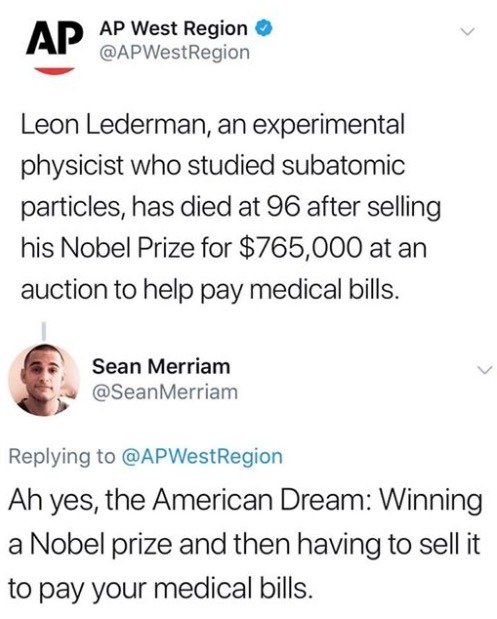#leon lederman
Text
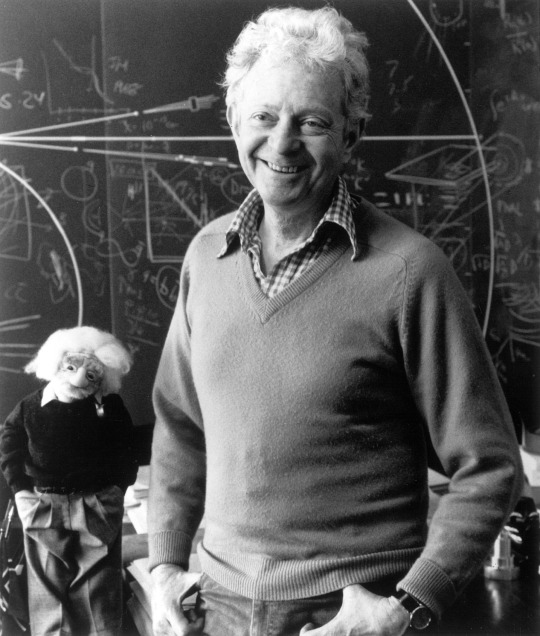
Uncredited Photographer Nobel Laureate Theoretical and Experimental Physicist Leon Lederman, Batavia IL c.1988
"Physics isn't a religion. If it were, we'd have a much easier time raising money." Leon Lederman
29 notes
·
View notes
Text
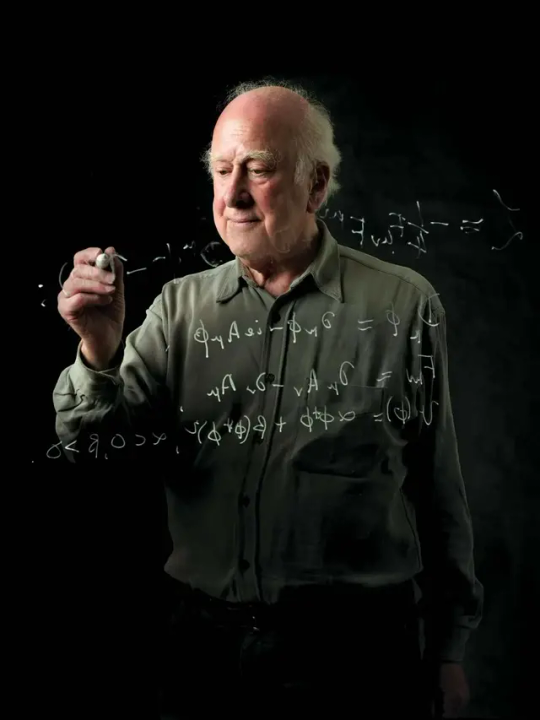
In 1964 the theoretical physicist Peter Higgs, who has died aged 94, suggested that the universe contains an all-pervading essence that can be manifested in the form of particles. This idea inspired governments to spend billions to find what became known as Higgs bosons.
The so-called “Higgs mechanism” controls the rate of thermonuclear fusion that powers the sun, but for which this engine of the solar system would have expired long before evolution had time to work its miracles on earth. The structure of atoms and matter and, arguably, existence itself are all suspected to arise as a result of the mechanism, whose veracity was proved with the experimental discovery of the Higgs boson in 2012.
The Nobel laureate physicist Leon Lederman infamously described the boson as “the God particle”. Higgs, an atheist, found this inappropriate and misleading, but the name stuck and helped bring fame to the idea, and to Higgs. He in turn became a Nobel prizewinner in 2013.
It was at Edinburgh University, as a young lecturer in mathematical physics in the early 1960s, that Higgs became interested in the profound and tantalising ways in which properties – mathematical symmetries – in the equations describing fundamental laws can be hidden in the structures that arise.
For example, in space, unaffected by the earth’s gravity, a droplet of water looks the same in all directions: it is spherically symmetric, in agreement with the symmetry implied by the underlying mathematical equations describing the behaviour of water molecules. Yet when water freezes, the resulting snowflake takes up a different symmetry – its shape only appearing the same when rotated through multiples of 60 degrees – even though the underlying equations remain the same.
The Japanese-American physicist Yoichiro Nambu first inspired interest in this phenomenon, known as spontaneous symmetry breaking, in 1960.
Inspired by Nambu’s work, in 1964 Higgs’s own theory emerged with its explanation of how equations that call for massless particles (such as the quantum theory of the electromagnetic field, which leads to the massless photon) can, via the so-called Higgs mechanism, give rise to particles with a mass.
This idea would later be at the root of Gerardus ’t Hooft’s proof in 1971 that unification of the electromagnetic force and the weak force, responsible for radioactivity, where a massive “W” particle plays the analogous role to the massless photon, is viable. The subsequent discovery of the W in 1983 gained Nobel prizes, both for the experiment and for theorists who had foreseen this. Underlying this success was the so-called Higgs mechanism, which controlled the mathematics in this explanation of the weak force.
When Nambu won the Nobel prize in 2008, it began to seem likely that the way was being prepared for Higgs’s eventual recognition.
A problem though, as Higgs was always the first to stress, was that he had not been alone in discovering the possibility of mass “spontaneously” appearing. Similar ideas had already been articulated: by the condensed matter physicist Philip Anderson, though in a more restricted way, and by Robert Brout and François Englert in Belgium, who beat Higgs into print by a few weeks. A former colleague of Higgs at Imperial College, Tom Kibble, and two colleagues were to write a paper along similar lines weeks later.
Where Higgs had justifiable claims to uniqueness was in the boson. He drew attention to the fact that in certain circumstances spontaneously broken symmetry implied that a massive particle should appear, whose affinity for interacting with other particles would be in proportion to their masses.
It would be discovery of this particle that could give experimental verification that the theory is indeed a description of nature. Although even this boson was arguably implicit in other work, it was Higgs who articulated most sharply its implications in particle physics.
The eponymous “Higgs boson” became the standard-bearer for the Large Hadron Collider. In the early 1990s the science minister William Waldegrave issued his challenge: explain the Higgs boson on a sheet of paper and help me to convince the government to fund this.
Among the winners, the most famous was the analogy, by David Miller of University College London, of Margaret Thatcher – a massive particle – wandering through a cocktail party at the Tory conference and gathering hangers-on as she moved. Higgs, whose politics were diametrically opposite to hers, expressed himself as being “very comfortable” with the description.
He was always uncomfortable as a celebrity. When Cern – the European Organisation for Nuclear Research – prepared to switch on the Large Hadron Collider (LHC) in 2008, the media promoted it as a quest for the Higgs boson.
Higgs felt that Cern was misguided to talk up “the” boson – he was always the first to stress that others had had much the same idea and that naming it after him was unfair. He once modestly described the detection of the boson as “tying up loose ends” and regarded the main excitement of the LHC as its potential to reveal the secrets of dark matter and other kinds of new physics.
Nonetheless, in July 2012, Cern announced the discovery of a particle “with Higgs-like properties”. Media frenzy grew, and Higgs bravely accepted his fate as a centre of attention.
Although most physicists were sure that the eponymous boson had been discovered, several months’ more study would be needed before complete confirmation could be assured: the Nobel prize for 2012 went elsewhere. By 2013 the evidence was compelling; there was a general expectation that 2013 would be the year.
By this stage, 49 years had elapsed since Higgs had written his first paper on the subject. In a final, nailbiting twist, the announcement of his long-awaited success was delayed by an hour as the Nobel committee struggled to reach the famously reclusive scientist. Aware of the media attention he was likely to get, Higgs had decided to be “somewhere else” when the announcement was made, and told colleagues that he planned to take a holiday in the north-west highlands of Scotland.
As the date approached, however, he realised that this was not a good plan for that time of the year, so he decided to stay at home and be somewhere else at the right time. At around 11am on 8 October, he left home and by noon, when the announcement should have been made, he was in Leith, by the shore, in a bar called the Vintage, which Higgs famously attested sold both food and “rather good beers”.
Thus with Higgs incommunicado (he largely avoided using mobile phones or the internet), after more than an hour of unsuccessful attempts to reach him, the Swedish Academy decided to make the public announcement anyway. The ironic result was that by 2pm, the news that Peter Higgs and Englert, of the Université Libre de Bruxelles, were the winners of the Nobel prize for physics was known to the world, but not to Higgs himself. (Englert’s colleague Brout had died in 2011, and was unable to be included as Nobel prizes are not awarded posthumously.)
Higgs later recalled how, “after a suitable interval”, but still ignorant of the news, he had made his way home from lunch. However, he delayed further by visiting an art exhibition, as “it seemed too early to get home, where reporters would probably be gathered”.
At about three o’clock he was walking along Heriot Row, heading for his flat in the next street, when a car pulled up near Queen Street Gardens. A lady got out “in a very excited state” and told Higgs: “My daughter’s just phoned from London and told me about the award.” To which Higgs replied: “What award?” As he explained, he was joking, but that is when his expectations were confirmed.
His plan had been a success, as, “I managed to get in my front door with no more damage than one photographer lying in wait.” A little more than a decade later, the main focus of the LHC has been to produce large numbers of Higgs bosons in order to understand the nature of the omnipresent essence that they form.
During the coronavirus lockdown I talked with him for hours on the phone at weekends in the course of researching the biography Elusive: How Peter Higgs Solved the Mystery of Mass (2022). When asked to summarise his perspective on public reaction to the boson he said: “It ruined my life.” To know nature through mathematics, to see your theory confirmed, to win the plaudits of peers and win a Nobel prize, how could this equate with ruin? He explained: “My relatively peaceful existence was ending. I dont enjoy this sort of publicity. My style is to work in isolation, and occasionally have a bright idea.”
Higgs spent more than half a century as a theoretical physicist at Edinburgh University. Perhaps because of this, he was described in many media reports as a “Scottish physicist”, whereas in fact he was born in Newcastle, of English parents, Thomas Ware Higgs and Gertrude Maud (nee Coghill).
His father was a sound engineer with the BBC, and the family moved almost immediately to Birmingham, where Peter spent his first 11 years. In 1941, with the second world war intensifying, the BBC decided that Birmingham was too dangerous, and its operations were transferred to Bristol. The Higgs family duly moved there, with the intention of avoiding aerial bombardment, but the following weekend the centre of Bristol was heavily bombed.
In Bristol, Higgs attended Cotham grammar school, where a famous former pupil had been the Nobel physicist Paul Dirac. Dirac’s name was prominent on the honours board. Higgs followed him, but initially in mathematics rather than physics. Higgs’s father had a collection of maths books, which inspired Peter and enabled him to be become far ahead of the class. His interest in physics was sparked in 1946, upon hearing the Bristol physicists, later Nobel laureates, Cecil Powell and Nevill Mott describing the background to the atomic bomb programme. Although this helped determine his career, Higgs himself later became a member of CND.
At King’s College London he studied theoretical physics, going on to gain his PhD in 1954. He was working on molecular physics, applying ideas of symmetry to molecular structure. His interests moved towards particle physics, although his office was on the same corridor as those of Rosalind Franklin and Maurice Wilkins, two of the co-discoverers of the structure of DNA, though his own work had no immediate link to their programme.
He won research fellowships, first at the University of Edinburgh (1954-56), then in London at University College (1956–57), and at Imperial College(1957–58). He was appointed lecturer in mathematics at University College London in 1958, and then moved to the University of Edinburgh in 1960, where he spent the rest of his research career. Initially lecturer in mathematical physics, in 1970 he was appointed reader and, in 1980, professor of theoretical physics. He was elected Fellow of the Royal Society of Edinburgh in 1974, and FRS in 1983.
He met his future wife, the linguist Jody Williamson, at a CND meeting in 1960. They married in 1963, and had two sons, Christopher and Jonathan. Although they separated, they remained friends until her death in 2008.
Higgs won several awards in addition to the 2013 Nobel prize. In addition to numerous honorary degrees, these included the 1997 Dirac medal and prize from the Institute of Physics, the 2004 Wolf prize in physics, the Sakurai prize of the American Physical Society in 2010, and the Edinburgh medal in 2013. That year he was also appointed Companion of Honour, and two years later he won the Copley medal of the Royal Society, the world’s oldest scientific prize.
His sons survive him.
🔔 Peter Ware Higgs, theoretical physicist, born 29 May 1929; died 8 April 2024
Daily inspiration. Discover more photos at Just for Books…?
16 notes
·
View notes
Text
Book Review: “The God Particle: If the Universe Is the Answer, What Is the Question?” - Full Book Review
The God Particle: If the Universe Is the Answer, What Is the Question? – Book Resume
“The God Particle: If the Universe Is the Answer, What Is the Question?” is a captivating exploration of particle physics, penned by Nobel Prize-winning physicist Leon M. Lederman and science writer Dick Teresi. The book takes readers on an exhilarating journey through the annals of scientific discovery, from…

View On WordPress
0 notes
Text

Pourquoi London
21—24 March
4 Princelet Street | London Spitalfields
Gertrude and Canopy Collections are thrilled to announce their first collaborative exhibition, Pourquoi London. For the past few years, both platforms have been championing alternative models to democratise the art industry and support emerging artists in a fast-changing art world. Set against the backdrop of an exceptional Grade-II listed building in the heart of Spitalfields, this exhibition showcases a curated cross section of some of the most compelling artists operating across both platforms.
Pourquoi London is presented in a space which is an antithesis to the white cube. Rather than being displayed in visual isolation against plain white walls, the artworks are placed into conversation with the history of the building and by extension, the historical context of London more broadly.
Pourquoi London is not just an exhibition, it is an exploration of the evolving language of art and an invitation to engage with the narratives that resonate with contemporary living artists. The London art scene has faced significant challenges in recent years and the impact of various global crises has been strongly felt by artists and galleries alike. The city increasingly needs to defend its place in the global art world, and the artists exhibited here help to highlight what it means to be an artist working in London today.
The exhibition is curated by Will Jarvis (CEO of Gertrude) and Louise Chignac (co-founder of Canopy Collections). It will feature over thirty artists including Francesca Anfossi, Anna Blom, Bokani, Richard J. Butler, Thomas Cameron, Helen Clarke, William Cobbing, Lara Davies, James Dearlove, Juliet Ferguson Rose, Abi Freckleton, Iris Garagnoux, Harriet Gillet, Richard Hards, Emmet Kierans, Charlotte Kingsnorth, Jon Kipps, Hannah Knox, Sarah Lederman, Ranny Macdonald, Dominic Myatt, Tamsin Nagel, Rebecca Parkin, Sarah Poots, Emerson Pullman, Leon Scott-Engel, William Stein, Emma Tod, Ian Whittlesea, Kate Williams, Aethan Wills, Salomé Wu.
Practical information
FREE entry
Exhibition open 22—24 March, 10am—7pm Public Opening: Thursday 21 March, 7—10pm 4 Princelet Street, London E1 6QH
0 notes
Text
July 15 Zodiac - Full Horoscope Personality
They believe that everybody should know them and gain general appreciation, yet they act modestly, as though they wouldn't fret drawing in the consideration of others. Thrifty, exceptionally moderate in their perspectives, they solidly stick to their standards. Heartfelt and frequently profound individuals, their minds are bizarrely created. In spite of the fact that their impact draws in others, they don't generally live together as one with their current circumstance. They are fairly bizarre naturally, and others can't necessarily comprehend what they endlessly don't need, which makes them mistaking for the climate. They appear to be viewed as an enigma, yet nothing could be further from reality. They are extremely delicate individuals who get profound effectively, exceptionally close to home, removed, to some degree bashful yet exceptionally joined to their objectives. Its most trademark include is its alterable mind-sets. They can likewise show huge peevishness, responsiveness, and apprehension, as long as they don't figure out how to control their impulses and temperaments. The weaknesses of this birthday: When such an individual isn't grown, then, at that point, his spirit turns into an assortment of insignificant impulses. Then, at that point, she becomes shaky and hesitant, particularly in everything connected with her sentiments and encounters. Be that as it may, when he arrives at a higher moral level, he starts to figure out how to control his emotional episodes and creates incredible resolution. These individuals seek after their objectives with industriousness and steadiness, and they accomplish them through politeness or ability or through applause and conviction, which they apply masterfully.
[subtitle id="attachment_19058" align="aligncenter" width="612"]July 15. Schedule Symbol with long shadow in a Level Plan style. Day to day schedule separated on blue foundation. Vector Representation (EPS10, very much layered and assembled). Simple to alter, control, resize or colorize.[/caption]
Zodiac sign for those brought into the world on July 15
On the off chance that your birthday is July 15, your zodiac sign is Malignant growth
July 15 Zodiac - Full Horoscope Personality
character: respectful, earnest, able, abominable, forceful, discourteous calling: secretary, orthopedist, performer tones: orange, green, yellow stone: emerald creature: coyote plant: hackberry fortunate numbers: 29,39,44,46,57,59 very fortunate number: 34
Occasions and observances - July 15
World Youth Abilities Day
July 15 VIP birthday celebrations. Who was conceived that very day as you?
1905: Enrique Laguerre, Puerto Rican author (d. 2005). 1909: William Cochran, Scottish analyst (d. 1980). 1913: Darrell Spat, American author (d. 2001). 1915: Manuel Giდºdice, Argentine soccer player (d. 1983). 1917: Juan Bonet, Spanish columnist and author (d. 1991). 1917: Nur Mohammad Taraki, Afghan scholarly, progressive and legislator (d. 1979). 1918: Bertram Neville Brockhouse, Canadian physicist, 1994 Nobel laureate in physical science (f. 2003). 1919: Argimiro Gabaldდ³n, teacher, painter and Venezuelan guerrilla (f. 1964). 1919: Iris Murdoch, Irish essayist and thinker (d. 1999). 1921: Robert Bruce Merrifield, American natural chemist, 1984 Nobel Prize victor in science (d. 2006). 1922: Leon Max Lederman, American physicist, Nobel laureate in material science in 1988. 1923: Anilda Leao, Brazilian artist, essayist, women's activist lobbyist, entertainer and vocalist (d. 2012). 1925: Philip Carey, American entertainer (d. 2009). 1925: Josep Mussons, money manager and Spanish games pioneer. 1925: DA Pennebaker, American movie producer and narrative creator. 1926: Leopoldo Galtieri, Argentine military and despot (f. 2003). 1927: Luis Dდ¡vila, Argentine entertainer (f. 1998). 1927: Carmen Zapata, American entertainer (d. 2014). 1928: Carl Woese, American microbiologist. 1930: Jacques Derridდ¡, French savant (d. 2004). 1930: Stephen Smale, American mathematician. 1931: Clive Cussler, American author. 1932: Josდ© Antonio Echeverrდa, understudy pioneer and Cuban progressive (d. 1957); killed by the Batista autocracy. 1933: Julian Bream, English guitarist and lute player. 1933: Guido Crepax, Italian artist and illustrator (d. 2003). 1934: Harrison Birtwistle, English author. 1935: Vდctor Female horses, Mexican entertainer (d. 2000). 1937: Horacio Garcდa Blanco, Argentine games writer (f. 2002). 1939: Anდbal Cavaco Silva, Portuguese lawmaker. 1941: Rodolfo Fogwill, Argentine author (d. 2010). 1942: Mil Mდ¡scaras (Aarდ³n Rodrდguez Arellano), Mexican expert grappler. 1942: Vivian Malone Jones, American social equality dissident. 1943: Jocelyn Chime Burnell, Northern Irish astrophysicist. 1944: Millie Jackson, American vocalist. 1946: Muda Hassanal Bolkiak, Bruneian king. 1946: Linda Ronstadt, American vocalist. 1947: Peter Banks, English guitarist, of the band Yes (d. 2013). 1947: Trevor Horn, English performer, of the band The Buggles. 1949: Carl Bildt, Swedish lawmaker. 1951: Jesse Ventura, ex-grappler and American lawmaker. 1951: Gregory Isaacs, Jamaican artist (d. 2010). 1952: Terry O'Quinn, American entertainer. 1952: Johnny Roars, artist and guitarist, of the band New York Dolls (f. 1991). 1953: Jean-Bertrand Aristide, Haitian progressive lawmaker and minister, leader of his country. 1953: Alicia Scaffolds, American artist. 1954: Mario Alberto Kempes, Argentine footballer. 1955: Carlos Iglesias, Spanish entertainer and chief. 1956: Ian Curtis, English artist, of the band Satisfaction Division (d. 1980). 1956: Antonio Fernდ¡ndez Garcდa, Spanish lawmaker. 1956: Marky Ramone, American drummer, of the band The Ramones. 1956: Joe Satriani, virtuoso American guitarist. 1959: Vincent Lindon, French entertainer. 1961: Woodland Whitaker, American entertainer and producer. 1963: Brigitte Nielsen, Danish entertainer. 1966: Amanda Foreman, American entertainer. 1966: Irene Jacob, French-Swiss entertainer and vocalist. 1966: Jason Bonham, English drummer, child of drummer John Bonham. 1967: Adam Savage, American TV have. 1968: Leticia Calderდ³n, Mexican entertainer. 1970: Chi Cheng, American bassist for the band Deftones. 1971: Iosu Olalla, Spanish handball player. 1973: Buju Banton Jamaican reggae vocalist. 1973: Mario Kempes Argentine footballer. 1973: John Dolmayan, Lebanese drummer, of the band Arrangement of a Down. 1976: Jim Jones, American rapper. 1976: Diane Kruger, German entertainer and model. 1976: Marco Di Vaio, Italian footballer. 1977: Lana Parrilla, American entertainer. 1977: Beam Toro, American guitarist, of the band My Synthetic Sentiment. 1978: Josდ© Antonio Delgado, Spanish artist lyricist. 1979: Travis Fimmel, Australian entertainer and model. 1979: Alexander Frei, Swiss footballer. 1980: Erika Sanz, Spanish entertainer and artist. 1981: Josდ© Marდa Calvo, Argentine footballer. 1981: Issa Gadala, Dominican artist lyricist. 1981: Peter Odemwingie, Nigerian footballer. 1981: Taylor Kinney, American entertainer and model. 1982: Jerდ³nimo Figueroa, "Momo", Spanish footballer. 1982: Aდda Yდ©spica, model and character on Venezuelan TV. 1990: Olly Alexander, English entertainer, artist and musician, of the band Years and Years. 1992: Koharu Kusumi, Japanese voice entertainer and artist, of the band Morning Musume. 1992: Watchman Robinson, American DJ and electronic music maker.
0 notes
Text
Thoughts on "Voices of the Descendants"
The third and final segment of our three-part program, “The Voices of Descendants of Holocaust Survivors in Writing” took place yesterday. I had the pleasure of conducting a conversation with Emanuel Rosen, the grandson of Dr. Hugo Mendel and his wife Lucie, and Noah Lederman, the grandson of Hadasa and Leon Lederman. Each man went on a long and arduous journey in search of clues about the…
View On WordPress
0 notes
Text
The Mind of God
The Mind of God
Einstein is known to have said, “I want to know the mind of God.” Nobel laureate Leon Lederman in his book The God Particle, writes about the quest for the single equation in physics that would combine Einstein’s theory of relativity and quantum theory into a single unifying theory. This Theory of Everything is the holy grail of physics. Will we ever know the mind of God?
Let us examine what we…
View On WordPress
0 notes
Text

14K notes
·
View notes
Text
Leon Lederman, a physicist and Nobel prize winner, passed away earlier this week at 96. I first discovered him when I bought his book; The God Particle, at age 16. It would be pointless to try and describe the depth and breadth of his impact on my life, so I won’t try. But I am deeply sad that we now live in a world without him.
When Leon developed dementia in his old age, his wife sold his Nobel prize statue for three quarters of a million dollars to help pay for his care, a fact that stands out for me as particularly sad, but also lucky, as most of us have nothing of that value in our 80s and 90s with which to finance whatever Medicare does not.
10 notes
·
View notes
Text

( his Nobel thank you 😂 - RIP, you sweet♥️ )
#leon lederman#fermilab#fermi national accelerator laboratory#nobel laureate#particle physics#a sweet and funny man#always approachable#rip#never talked down to me#childhood nerd crush
1 note
·
View note
Photo
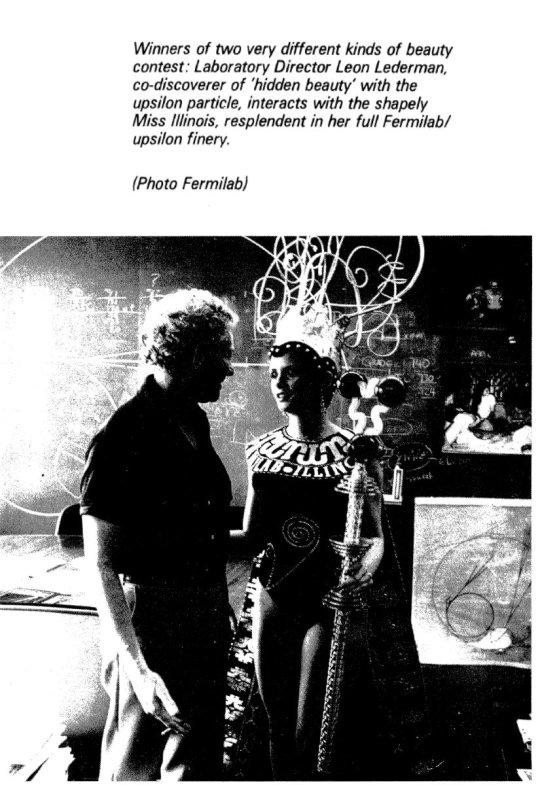
https://history.fnal.gov/lederman.html
1 note
·
View note
Text
The Voices of Descendants: The Continued Impact of the Holocaust
The third meeting in our three-part program about the voices of the second and third generation in writing will take place via Zoom on Tuesday May 2/2023 at 2:30 pm EDT. The program will host two grandsons who published books about the history of their families. Those wishing to join can register by following the link obtained by clicking on the image below.
Noah Lederman is the grandson of Leon…

View On WordPress
0 notes
Photo
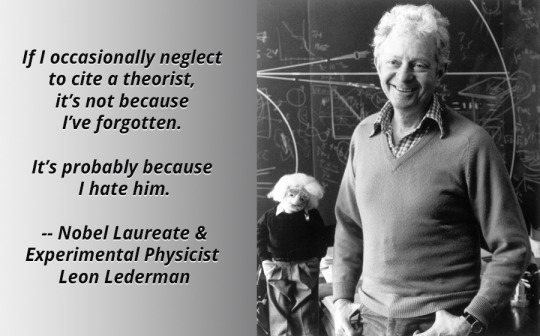
"It's not because I've forgotten." Leon Lederman [900x560][OC]
0 notes


